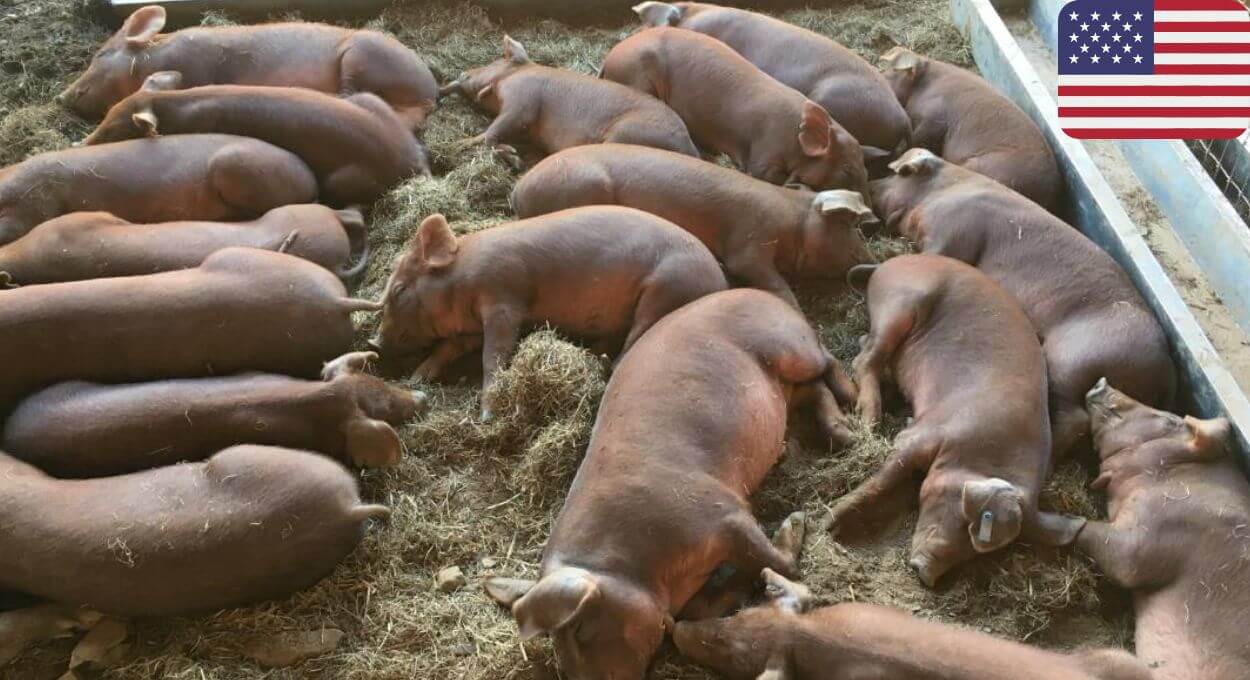
The Red Wattle pigs’ history is shrouded in mystery. Some believe that the origins of this pig breed can be traced back to the mid-1800s somewhere in Texas, with possible links to other regions through the Gulf of Mexico.
Over time, the popularity of Red Wattle pigs declined, and the breed was almost lost. Fortunately, the modern history of the Red Wattle pig breed is better documented.
It began in the early 1970s when H.C. Wengler discovered some descendants of the breed in East Texas. He crossbred two-wattled red sows with a Duroc boar and developed the Wengler Red Wattle line. Twenty years later, Robert Prentice managed to find another group of animals that later became the Timberline line of Red Wattles.
In the mid-1980s, all Red Wattle breeders decided to form an association and fight for the breed’s survival. By 1999, there were only 42 breeding animals left across six breeders.
The Red Wattle Hog Association continues to exist and fight, with the support of the Livestock Conservancy, for the development and growth of this pig breed throughout America.
Contents
What is a Red Wattle pig?
The Red Wattle pig is a rare heritage swine breed. This pig breed is classified by the Livestock Conservancy on the Threatened list of the American Livestock Breeds Conservancy (ALBC).
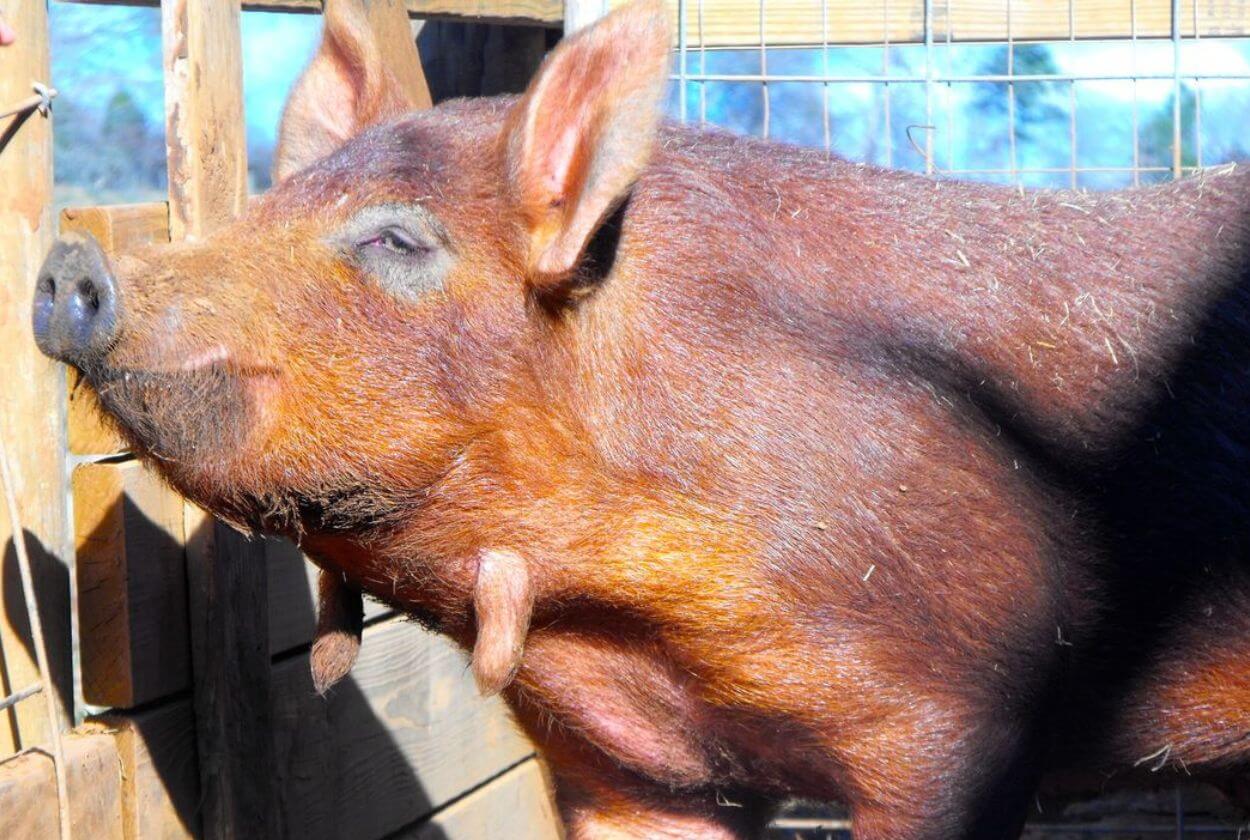
Red Wattle Pig Characteristics
Physical Characteristics
Color
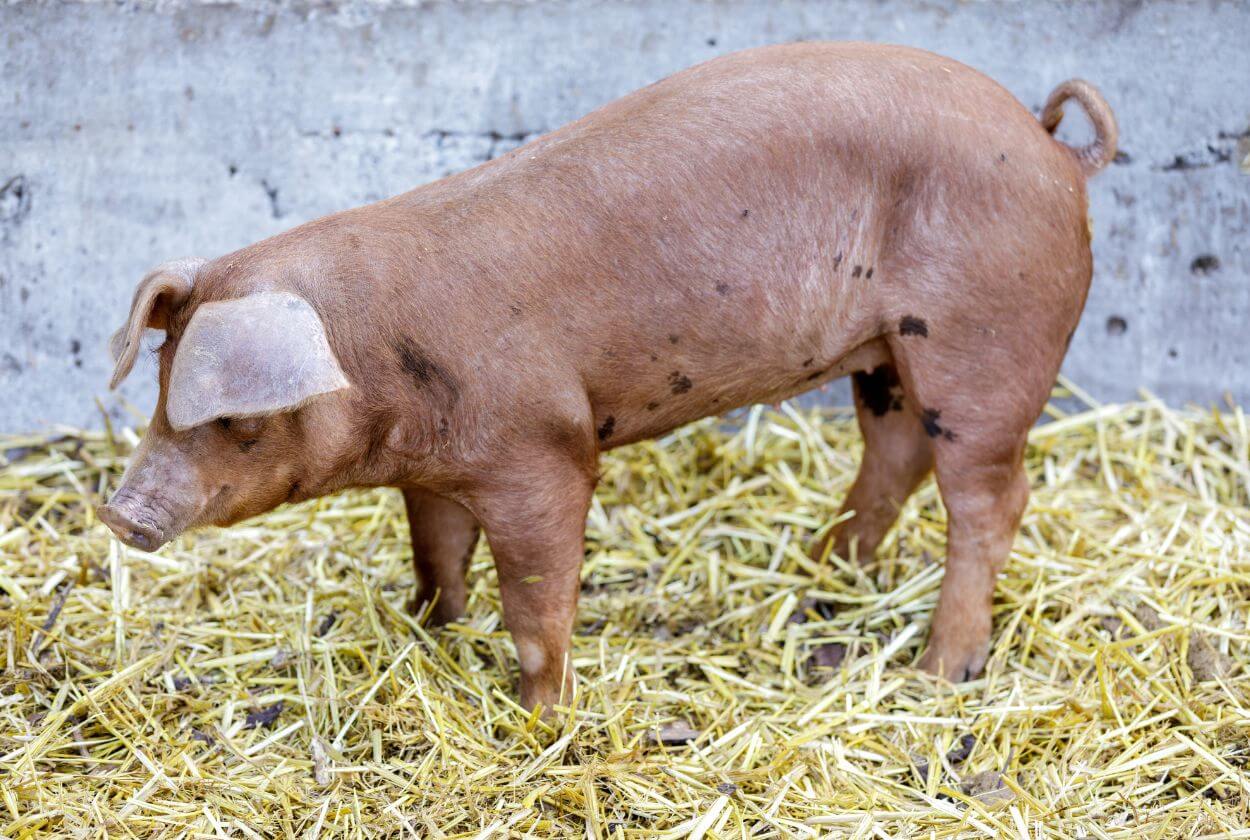
The Red Wattle pig color is red, but it can also be found in shades of light blond or even mostly black.
There are Red Wattle pigs that have black spots. When a Red Wattle pig has black spots, it can only be registered as an official breed if the spots are small and confined to the belly area.
Hair
These pigs can have long and wavy hair while others can exhibit short and straight hair.
Size
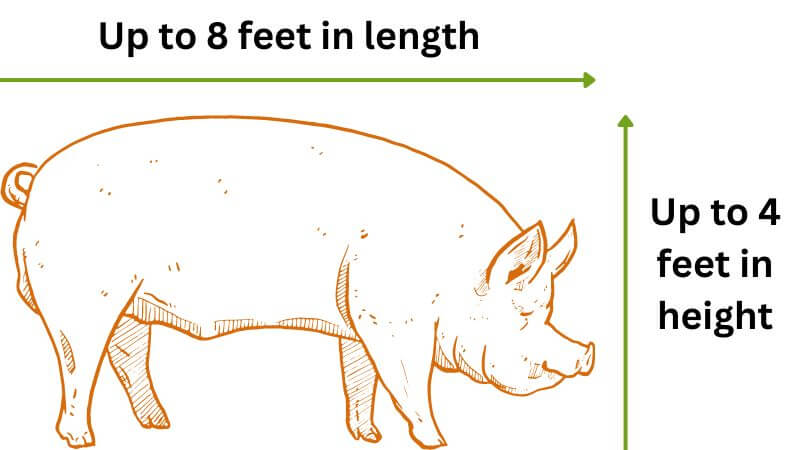
The Red Wattle is a large pig breed, with a mature pig measuring up to 4 feet in height and 8 feet in length.
Body
The body of the Red Wattle pig is muscular and sturdy. The back of these pigs must be arched a bit toward the rear while the underline or belly must be straight.
Legs
The legs of these pigs are muscular, strong, and thick to support their weight when they reach maturity. Additionally, they have a wide space between the front and rear legs to provide proper support, and the dew claws are off the ground when the pig is standing normally.
Tail
The tail of the Red Wattle pig is positioned right at the end of the back arch, towards the rear.
The tail’s position is important as it indicates the location of the reproductive organs for breeding and farrowing. If the tail is not placed correctly, it could lead to issues such as infertility.
Chest
The chest of the Red Wattle pig is broad, muscular, heavy, and wide. Just like the back legs, the front legs also have a significant gap between them, which is a result of the wide chest.
Head
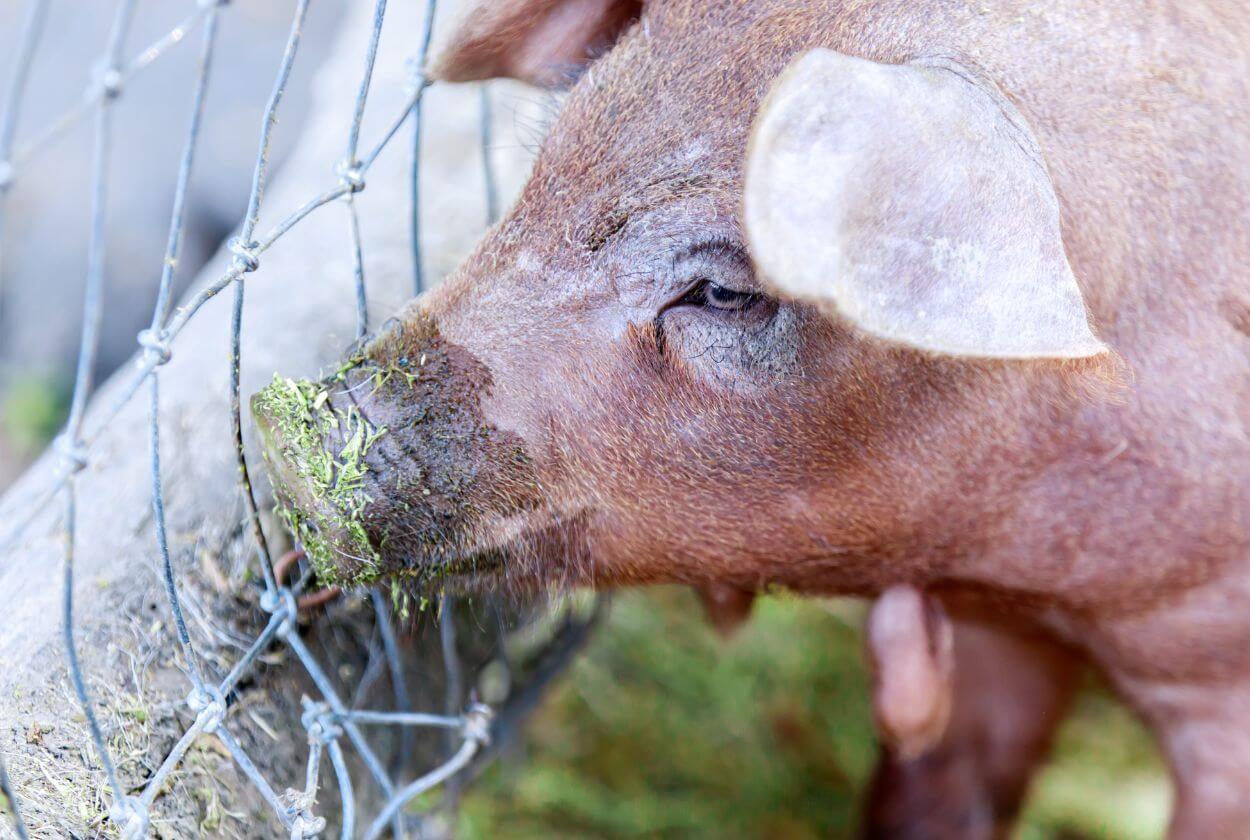
Red Wattle pigs are known to have a “dish face.” They do not have a sloped nose or face; instead, their snouts originate from the forehead and have a slight curve. This small curve is not present in piglets but becomes noticeable in mature pigs.
Teeth
Red Wattle pigs have a total of 44 teeth once they reach maturity.
But what makes their teeth truly fascinating is not just the number, but the fact that their teeth are covered in an enamel coating similar to human teeth.
This enamel coating contributes to the strength and durability of Red Wattle pig teeth.
Ears
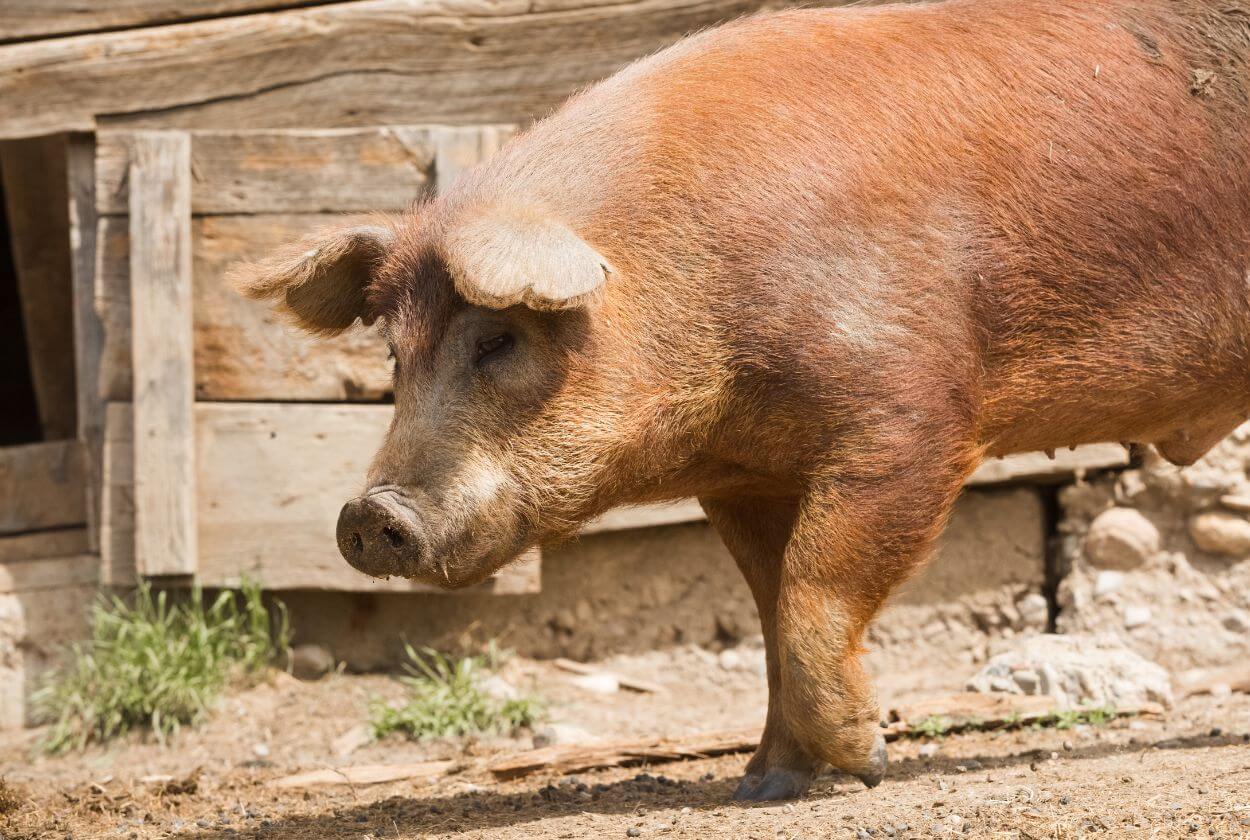
The Red Wattle pigs’ ears are large and partially cover their eyes. When they want to see better, these pigs have the ability to slightly move their ears to the side.
That is not all. Their ears are cupped, meaning they have a fold behind them. Some pigs may have a single crease on one ear, while others may possess creases on both ears at varying levels.
They are considered a single-gene characteristic, meaning that they are passed on to the offspring when Red Wattle pigs are crossbred.
Teats
Both sow and boars have 12 teats. Teats are evenly distributed from front to back and are consistently aligned in pairs.
Lifespan
Red Wattle pigs have a lifespan ranging from 9 to 15 years. The exact lifespan depends on various factors that influence their well-being, including diet, healthcare, and living conditions.
With proper care, Red Wattle pigs can live up to 15 years or even longer.
Growth Rate
How fast do Red Wattle pigs grow?
Red Wattle pigs grow rapidly and can reach butcher weight in approximately 7 months.
Their growth rate can even be compared to that of commercial pig breeds.
The average feed conversion is quite impressive, as they efficiently convert feed into body weight within a relatively short period. They tend to first develop muscle and after that accumulate fat.
However, it’s important to note that if the butchered weight is excluded, generally reaches maturity around 3 years old.
Weight
The Red Wattle pig can weigh between 700 and 800 lbs, with some larger individuals reaching weights close to 1,200 lbs.
These pigs can reach their maximum weight in approximately 1 1/2 years, with some reaching 1,200 lbs by the age of 3 years.
Most Red Wattle breeders and farmers prefer pigs to have a butcher weight of around 300 to 325 lbs, with a hanging weight of approximately 245 lbs. This butcher weight is typically achieved within a 7-month period of rapid fat growth.
Slaughter Time
Red Wattle pigs are typically ready for slaughter between 7 to 8 months of age or when they reach the weight of 245 lbs, which is typically achieved within the first 7 months of their life. These numbers are averages, but there may be slight variations.
Temperament and Behaviour
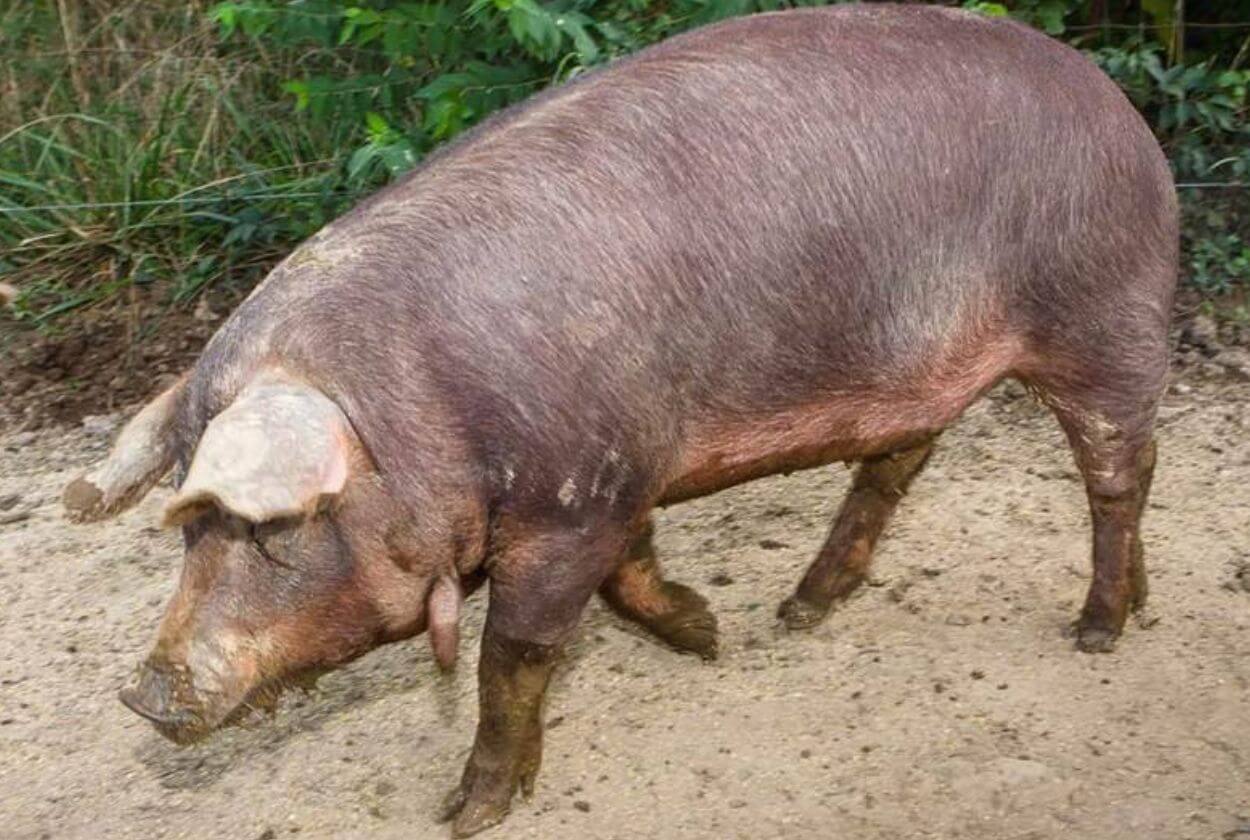
Red Wattle pigs are not at all aggressive pigs, but they are rather known for their mild temperament. They are docile and have friendly behavior.
Despite their large appearance, these pigs have a calm and gentle nature, making them easy to work with.
They enjoy socializing and living in herds, forming strong bonds with their herd members. Their sociability extends beyond their own breed, as they can interact well with other pig breeds and animals too.
Curious and intelligent, Red Wattle pigs quickly learn and adapt with remarkable agility. When provided with a large access area, they eagerly explore every part of it.
In terms of behavior, Red Wattle pigs have a strong foraging instinct, which is a prominent characteristic. This natural behavior for foraging sets them apart and makes them relatively more independent compared to other pig breeds.
They enjoy rooting and searching for food, an activity that not only satisfies their physical needs but also stimulates their mental activity, promoting their overall mental well-being.
Red Wattle piglets particularly adore playtime, engaging in activities such as running, chasing one another, and interacting with various objects. This playful behavior, which begins during their piglet stage, contributes to their friendly demeanor and makes them easy to care for as they mature into adult pigs.
Lastly, Red Wattle sows have excellent mothering skills, displaying gentleness towards their piglets, being protective, and providing them with the necessary care they require.
Meat
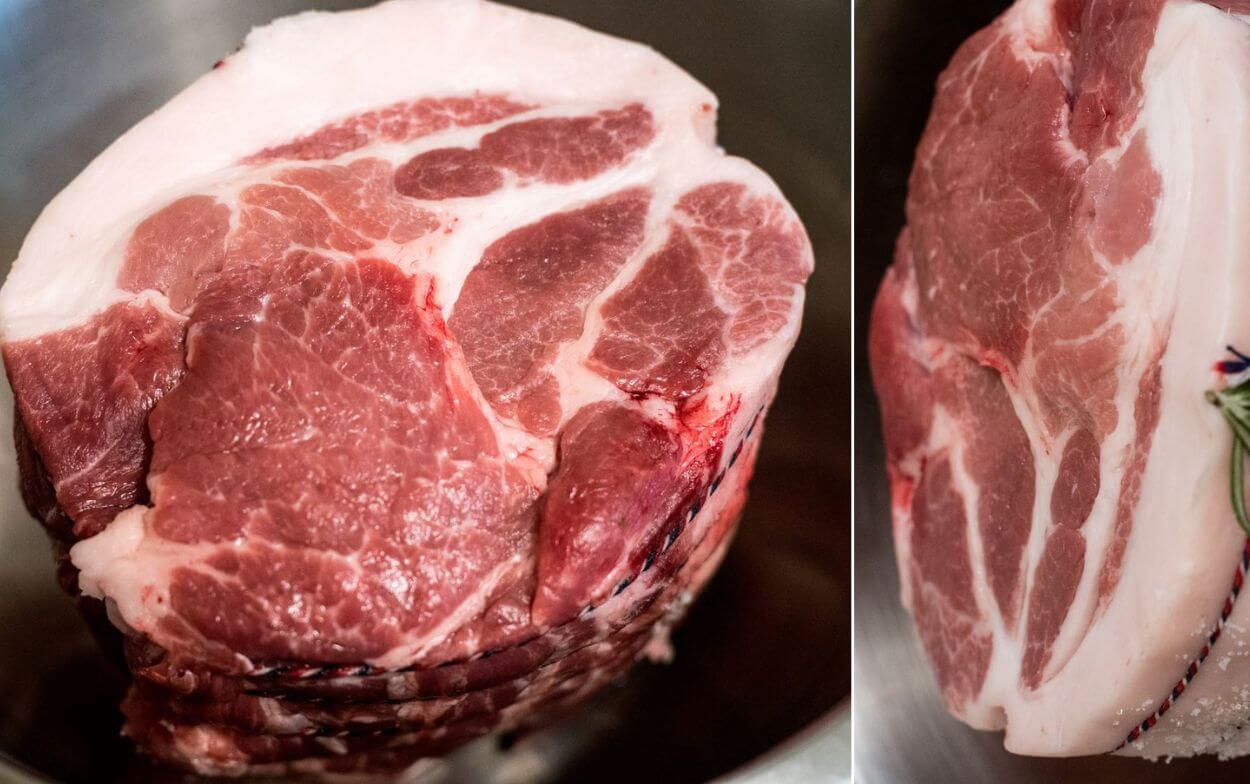
The Red Wattle meat is highly colored, with a high percentage of lean meat yet still possessing an adequate amount of fat, resulting in a well-marbled appearance.
The taste of Red Wattle pork is extremely flavorful, while the texture is juicy and tender. Many people who try Red Wattle say it is similar to beef rather than the typical white meat of other pig breeds, making it distinct from commercial pork.
But what is the source of this meat’s uniqueness?
The quality of Red Wattle pig meat comes from the pigs’ diet, which is rich in minerals and vitamins. As these pigs root and graze on pasture, they acquire a wide range of essential nutrients from the soil, contributing to the delightful flavor of the meat.
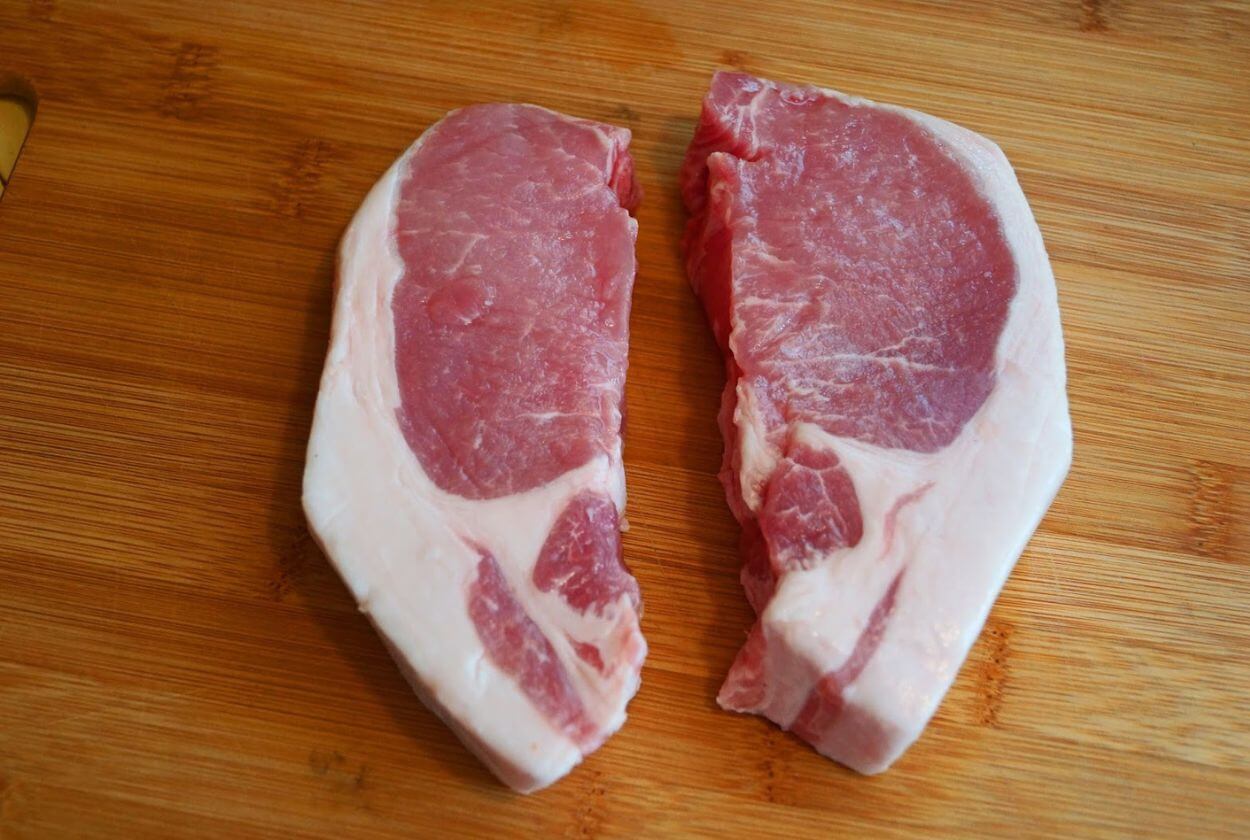
The majority of Red Wattle pork cuts consist of lean meat, although there are cuts with higher fat content. Lean cuts include tenderloin, spareribs, neck, and boneless pork roasts. These cuts are known for their lower fat content and are considered lean sources of protein. Cuts such as loins, belly, and ham have a higher fat content.
The meat of Red Wattle pigs is high in protein and contains abundant vitamins and minerals, making it a nutritious choice. It is a good source of thiamine (B vitamin), selenium, zinc (beneficial for the immune system), vitamin B12, vitamin B6, niacin, phosphorus, and iron.
Similar to other meat options, Red Wattle Pig has a combination of saturated and unsaturated fats, with a relatively balanced distribution. The fat content generally falls within the range of 10–16%, although it can exceed this range depending on variables such as cooking methods and trimming.
Growing Red Wattle Pigs
Feeding
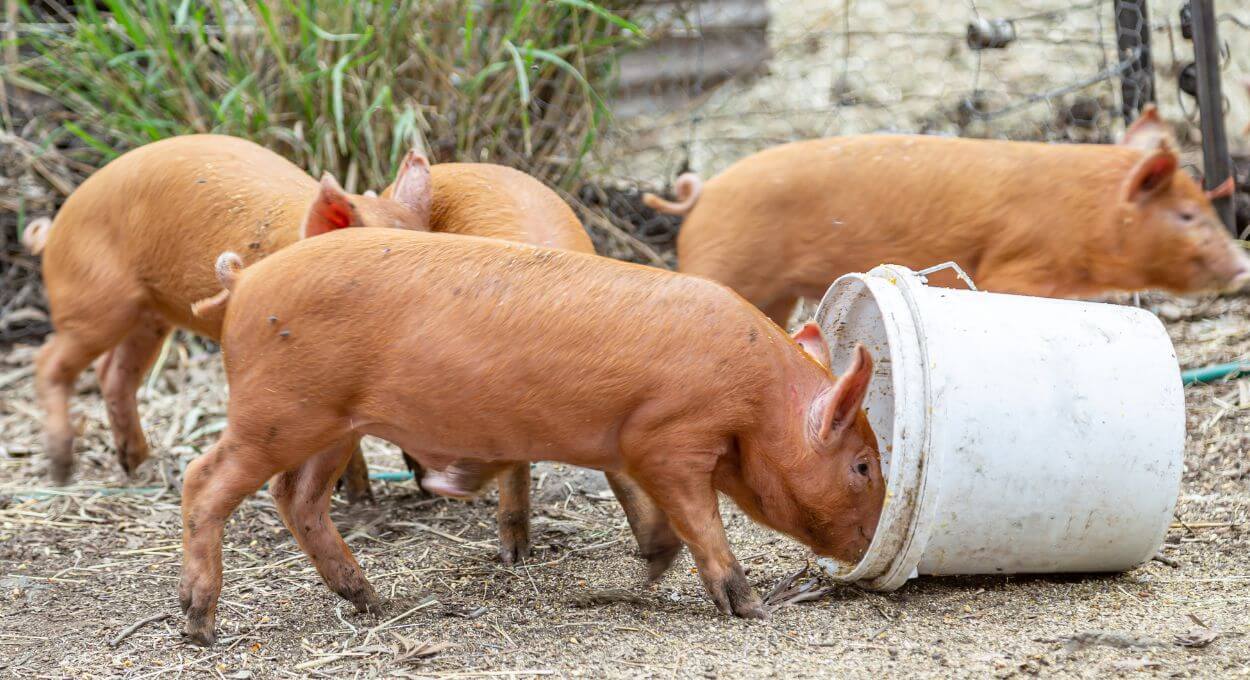
Raising Red Wattle pigs is relatively easy, but let’s make it even easier by understanding what they need to be fed.
As mentioned earlier, they are excellent foragers and have a natural inclination for rooting. This trait makes them well-suited for pasture settings, as they increase the soil’s level of nutrients and serve as efficient grazers.
While their foraging habits allow them to consume a significant amount of grass and plant roots, it’s important to provide them with a daily ration of supplemental food for proper development and muscle growth. The reason for this is that grasses and vegetables alone may not provide sufficient high-quality protein to meet their needs.
In the beginning, the Red Wattle piglets will be fed by the sow, but once they reach a weight of around 40 to 50 lbs, they are ready to explore and find their own food in the pasture.
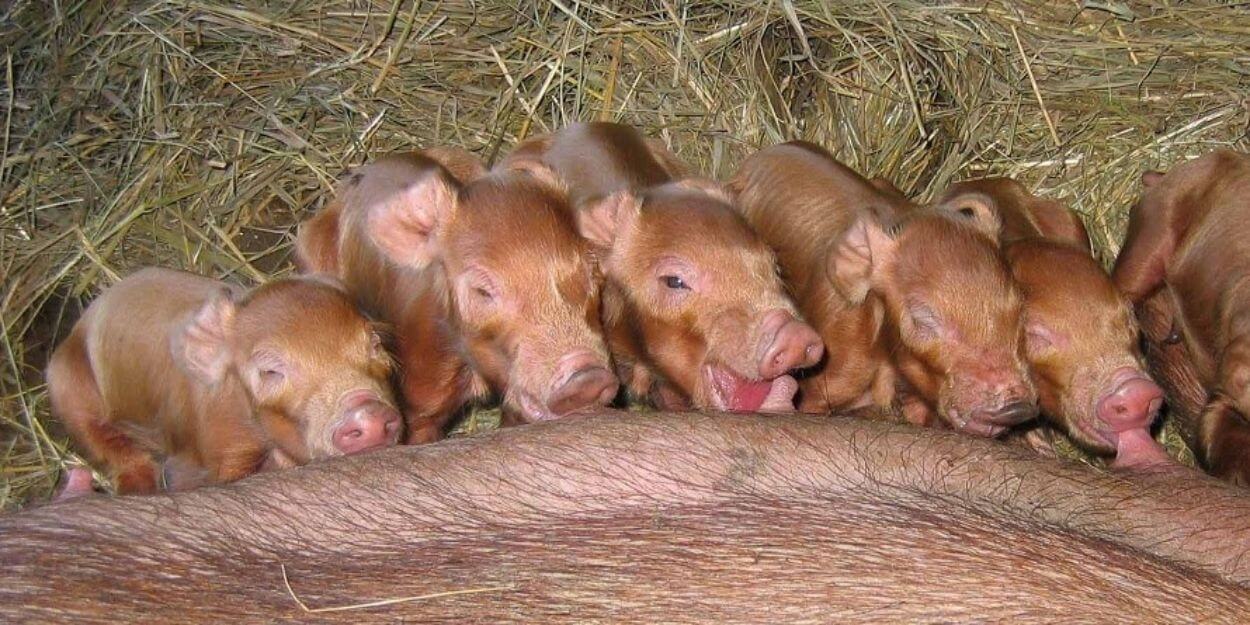
But, what to feed these pigs apart from grasses like alfalfa and cover?
Besides those, you should supplement their daily diet with grains such as oats, barley, wheat, and beans. It is also important to add vitamin and mineral supplements to their daily feed.
Other additions to their diet can include fresh vegetables and fruits, which can serve as supplemental treats and provide additional vitamins. Examples of suitable options include carrots, pumpkins, apples, and greens.
What not to feed
You should avoid feeding Red Wattle pigs moldy or excessively old food, as it may irritate their stomach. Other things you should not feed them are trash or food waste from restaurants or other sources that could be high in carbohydrates, salts, or sugar in their diet.
Water Intake
Fresh water is essential for the healthy growth of Red Wattle pigs. Once you decide to raise these pigs, you have to consistently provide them with access to fresh water. Drinking water helps them regulate their body temperature and distribute nutrients throughout their bodies.
On average, a Red Wattle pig can consume approximately 2 to 5 gallons of water per day per 100 lbs of body weight.
Environment
The ideal environment for Red Wattle pigs is an open outdoor space with free access to pasture surrounded by an electric fence to keep predators away.
Since they are natural foragers, these outdoor spaces allow them to root and feed on grasses and vegetables while also engaging in socialization with other pigs and animals.
Providing them with ample outdoor space and a wallow will create a good environment for pigs to exercise and develop healthy muscle growth.
What is surprising about these pasture pigs is that they can also adapt well to pig pens. If you don’t have enough space for outdoor grazing, you can raise them in enclosed spaces such as barns.
When using pig pens, it’s important to ensure that the pigs have sufficient space to move and turn comfortably. Proper ventilation and temperature control should also be in place to maintain optimal conditions for the pigs.
Regular cleaning of their living space is crucial when raising Red Wattle pigs in pens or other types of closed systems to maintain hygiene and minimize the risk of diseases.
Climate
Whenever you live in colder or hotter climates, it’s important to know that Red Wattle pigs are adaptable to various environments and climates. They are hardy pigs that do and develop well in a wide range of conditions.
In warmer climates, you should provide them with a wallow. These pigs enjoy wallowing in mud to bathe and regulate their body temperature. The mud also acts as a protective layer against the sun and bugs.
If a natural wallow is not possible, you can provide alternatives such as sprinklers, pools, or even artificial ponds to help them stay cool and comfortable.
Shelter
Red Wattle pigs do need shelter to protect them from extreme weather conditions, including heat, cold, rain, and strong winds.
The type of shelter used can vary depending on the farmer’s preference.
A traditional barn or housing structure with proper ventilation, insulation, and bedding such as straw can be used. Alternatively, portable shelters are available, offering the flexibility to move them as needed. These shelters are lightweight and easy to transport.
Regardless of the chosen shelter type, it is crucial to ensure good ventilation, proper drainage, and regular cleaning and maintenance.
How many Red Wattle pigs per acre?
You can raise approximately 3 to 5 Red Wattle pigs per acre.
The actual number can vary depending on the farm or homesteading space and conditions. If you want to determine the ideal pig numbers for your pasture, you can start by evaluating factors like soil quality and the amount of vegetation available.
Firstly, obtain soil data by conducting a soil test.
After making the test, assess the vegetation level on your pasture. Is there sufficient vegetation to sustain the desired number of pigs? You can make adjustments by adding or reducing the number of pigs or by splitting them into different areas. The key is to ensure that there is enough vegetation to meet the grazing needs of all the pigs on the pasture.
Breeding Red Wattle pigs
The heat cycle of Red Wattle sows lasts 21 days, similar to other sow types.
Before mating, make sure your sow is in the heat stage, which is the active heat period when the sow is sexually receptive. This stage typically lasts between 34 to 44 hours.
When breeding Red Wattle pigs, it’s important to consider that it can be more difficult for females to get pregnant during the heat of summer. If possible, I would suggest you schedule breeding for cooler periods.
The gestation period of Red Wattle sows lasts for 114 days, which is equivalent to 3 months, 3 weeks, and 3 days, while the litter size of Red Wattle pigs ranges from 10 to 15 piglets. Red Wattle sows are known for being excellent mothers and taking good care of their piglets.
Natural mating
The breeding of Red Wattle pigs is not much different from other pig breeds. Whether you are breeding them for pork production or to continue developing the breed, you will need a sow or gilt and a boar.
Both the sow and boar should reach a hanging weight of 245 lbs before being mated or mature enough for breeding, which typically occurs around 7 months of age.
What I recommend to you is to select a sow and boar that have similar weights, ages, and heights. Choosing a larger boar could injure the sow, so it’s best to keep them relatively similar in size.
Artificial Insemination
If you want to breed Red Wattle pigs through artificial insemination, depending on your goals, it is good to check with the relevant associations that provide certification. In some cases, these associations may require approval for conducting artificial insemination.
Red Wattle pig health issues
Red Wattle pigs are generally known for their hardiness. Still, they can suffer from certain diseases and health issues throughout their lifespan.
According to the Red Wattle Hog Association, some of the illnesses and injuries that Red Wattle pigs may experience include:
– Coccidiosis
– Dippity pig syndrome
– Erysipelas
– Hernia
– Pneumonia and swine flu
– Rectal prolapse
Additional Tips
– If you have Red Wattle piglets, I would recommend letting them stay with the sow for almost 8 weeks. While 6 weeks are generally sufficient, those extra two weeks will boost the piglets’ immune systems.
Ensure that you feed the sow appropriately during those additional two weeks.
– Always use an electric fence to keep the pigs in a designated area and ensure their safety. You should keep piglets apart from mature pigs on the pasture. Their small size may allow them to escape through the electric wire. Thus, separate the piglets until they are large enough to prevent such incidents.
– Consider planting grasses in your pasture specifically for the pigs. If you have sufficient space, you can raise chickens and utilize their eggs as feed. This approach helps reduce the cost of commercial feed.
– I would also suggest you castrate the piglets. Although this practice is controversial, it is necessary, particularly with piglets. Castration helps prevent boar taint, reduces the risk of unexpected pregnancies, and keeps them calm.
Why should you raise Red Wattle pigs?
Profitability
Can raising Red Wattle pigs be a profitable business? Absolutely! However, it’s important to consider that profitability can be influenced by factors such as your location and the local market conditions.
When raising them at a small to medium scale, you can make money by:
– Selling piglets by having your own breeding program. A certified Red Wattle piglet can cost between $80 to $100.
– Selling meat. The Red Wattle pork price is about $4 to $6 per lb on its live weight.
– Selling mature pigs. The price for a certified Red Wattle boar or sow is between $250 and $300.
– Selling boar semen. A semen dose can cost between $40 to $45.
– Making farm tours and tourism. You can always create your own adventure and invite people to learn more about raising Red Wattle pigs, letting them taste the meat and offering them facts and tips.
Still, when looking for profitability, you have to be careful with expenses as well. Being a larger pig breed, Red Wattle pigs consume more supplemental food compared to smaller pasture pigs like Idaho Pasture pigs. Some pig raisers may face challenges with their feed budget.
It is not critical, but it is crucial to find a system that works for you.
For example, ensuring that your pasture is rich in grasses and vegetables, raising chickens for eggs, and planting your own vegetables like carrots to feed the pigs.
Another good idea is to ask for the help of your neighbors. So, if there are other farms nearby or neighboring farms, you can ask for their assistance by providing buckets and kindly asking them to contribute any food scraps for your pigs.
Pigs can consume various kitchen leftovers, including vegetable peels, stale bread, rice, and pasta.
Personal Use
If you choose to raise Red Wattle pigs for personal use, you will obtain meat that is rich in nutrients and vitamins, which can help reduce your grocery budget. Let’s not forget about the quantity of lard as well, which comes in handy in homesteading.
To get a better idea, let’s see how much meat you can get from a single Red Wattle pig.
For example, let’s consider a Red Wattle pig weighing 250 lbs live weight. After butchering the pig and removing the hide, head, and guts, you are left with approximately 60 to 65% of the original weight, resulting in a reduction to around 162 lbs per pig. When the meat is further processed into chops and roasts, the net weight of meat obtained from a Red Wattle pig is approximately 120-130 lbs.
Advantages and Disadvantages
The Red Wattle pig has its advantages and disadvantages that farmers or homesteaders should consider when deciding to raise this breed. Here is the list of pros and cons of this pig breed:
| Pros | Cons |
|---|---|
| Flavorful and marbled meat | Limited availability and breed numbers |
| Good lard | Require pasture management |
| They are hardy and adaptable | Limited availability of Red Wattle-specific feed and supplies |
| The majority of the time they are independent because they are good foragers and grazers | Higher feed consumption |
| Can thrive in pasture-based systems | |
| Strong maternal instincts | |
| Great litter size | |
| Fast growth-rate |
Buying a Red Wattle pig
If you decide that the Red Wattle breed is suitable for you and you wish to raise it, the next step is acquiring the pigs. Depending on your preferences and goals, you can purchase piglets, mature pigs, boars, or sows.
Like any other pig breed, when purchasing a Red Wattle pig, it is important to identify a reputable breeder who specializes in raising Red Wattle pigs. Ensure that the breeder maintains healthy pigs and can provide you with all the necessary documentation, including certificates and registration papers.
After finding a breeder, I would suggest you visit personally the farm to see the pigs in person and evaluate them. Even with certification, it is good to observe the specific Red Wattle pigs’ traits. While certain traits may not be fully apparent in piglets, you can assess their health, overall appearance, and whether they are well-fed.
Red Wattle Pig Registration
To register and obtain certification for your Red Wattle pigs, they must meet the minimum standard traits of the breed, which include the physical characteristics detailed earlier. Additionally, a DNA sample may be required for evaluation.
It is important to check the specific requirements of the association you wish to register with, as the timing/age for certification may vary between different organizations. It is also crucial to consider any associated fees or taxes imposed by the association.

